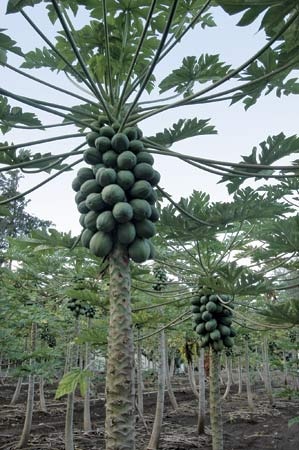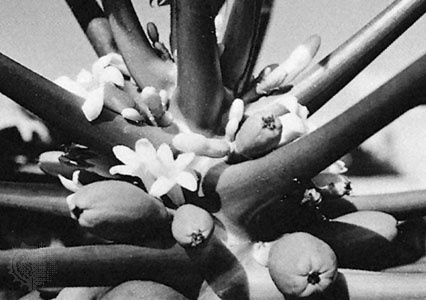papaya
fruit
also called papaw, or pawpaw

 succulent fruit of a large plant (Carica papaya) of the family Caricaceae that is considered a tree, though its palmlike trunk, up to 8 m (26 feet) tall, is not as woody as the designation generally implies. The plant is crowned by deeply lobed leaves, sometimes 60 cm (2 feet) across, borne on hollow petioles 60 cm long. Normally, the species is dioecious, male and female flowers being produced on separate plants; but hermaphroditic forms are known, and numerous irregularities in the distribution of the sexes are common. Male flowers are borne in clusters on stalks 90 cm long; the flowers are funnel-shaped, about 2.5 mm (0.1 inch) long, and whitish, and the corolla is five-lobed, with 10 stamens in the throat. The female flowers are considerably larger, on very short stalks, and often solitary in the leaf axils; they have five fleshy petals that are united toward the base and a large cylindrical or globose superior ovary that is crowned by five fan-shaped sessile stigmas.
succulent fruit of a large plant (Carica papaya) of the family Caricaceae that is considered a tree, though its palmlike trunk, up to 8 m (26 feet) tall, is not as woody as the designation generally implies. The plant is crowned by deeply lobed leaves, sometimes 60 cm (2 feet) across, borne on hollow petioles 60 cm long. Normally, the species is dioecious, male and female flowers being produced on separate plants; but hermaphroditic forms are known, and numerous irregularities in the distribution of the sexes are common. Male flowers are borne in clusters on stalks 90 cm long; the flowers are funnel-shaped, about 2.5 mm (0.1 inch) long, and whitish, and the corolla is five-lobed, with 10 stamens in the throat. The female flowers are considerably larger, on very short stalks, and often solitary in the leaf axils; they have five fleshy petals that are united toward the base and a large cylindrical or globose superior ovary that is crowned by five fan-shaped sessile stigmas.The fruit is commonly spherical to cylindrical in form, is 75 to 500 mm or even more in length, and sometimes weighs as much as 9 to 11.5 kg (20 to 25.5 pounds). In general character it strongly resembles a muskmelon. The very juicy flesh is deep yellow or orange to salmon-coloured and about 25 mm thick. Along the walls of the large central cavity are attached the numerous round, wrinkled black seeds, the size of peas.
Though its origin is rather obscure, the papaya may represent the fusion of two or more species of Carica native to Mexico and Central America. Today it is cultivated throughout the tropical world and into the warmest parts of the subtropics.
The papaya fruit is slightly sweet, with an agreeable musky tang, which is more pronounced in some varieties and in some climates than in others. It is a popular breakfast fruit in many countries and is also used in salads, pies, sherbets, juices, and confections. The unripe fruit can be cooked like squash.
The unripe fruit contains a milky juice in which is present a protein-digesting enzyme known as papain, which greatly resembles the animal enzyme pepsin in its digestive action. This juice is used in the preparation of various remedies for indigestion and in the manufacture of meat tenderizers.
Papayas are usually grown from seed. Their development is rapid, fruit being produced before the end of the first year. Under favourable conditions, a plant may live five years or more.
- Glomar Challenger
- Glomma
- Gloria Macapagal Arroyo
- Gloria Naylor
- Gloria Steinem
- Gloria Swanson
- Gloriosa
- Glorious Revolution
- glory-bower
- glossematics
- glossitis
- Glossopteris
- glottal stop
- glottis
- glottochronology
- Gloucester
- Gloucester, Gilbert de Clare, 8th Earl of, 9th Earl Of Clare
- Gloucester, Henry Stuart, Duke of
- Gloucester, Humphrey Plantagenet, Duke of
- Gloucester, Richard de Clare, 7th Earl of, 8th Earl Of Clare, 6th Earl Of Hertford
- Gloucester, Robert, Earl of
- Gloucestershire
- Gloucester, Thomas of Woodstock, Duke of
- glove
- Glover, Savion